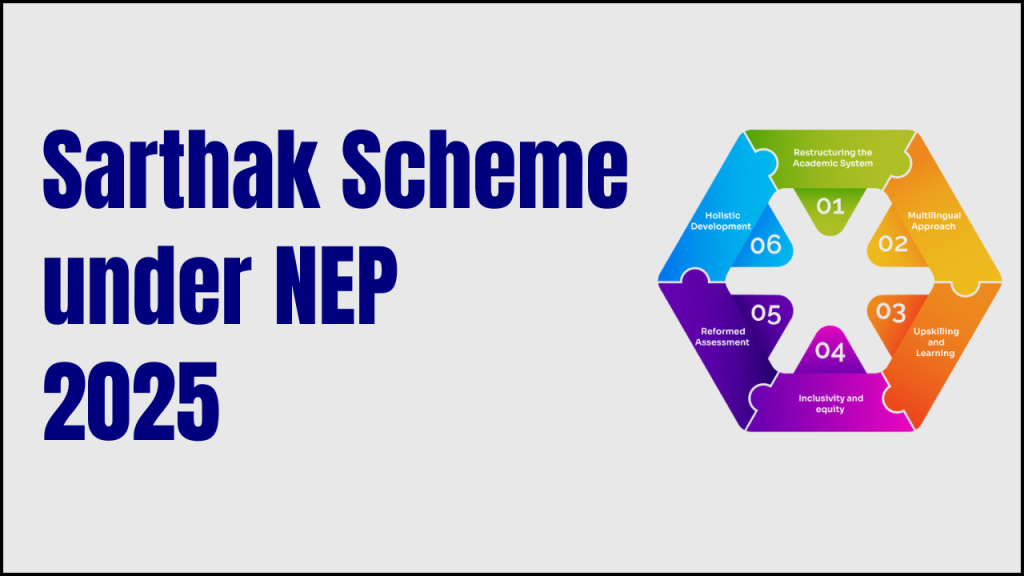
The Sarthak Scheme, introduced as part of the National Education Policy (NEP) 2025, represents a transformative initiative aimed at enhancing the quality and accessibility of education in India. Rooted in the principles of inclusivity, equity, and holistic development, the Sarthak Scheme focuses on addressing the evolving needs of students and educators. This article explores the key aspects, objectives, and impact of the Sarthak Scheme within the framework of NEP 2025.
Introduction to the Sarthak Scheme
The Sarthak Scheme was conceptualized to support the implementation of the NEP 2025. It provides a roadmap for achieving the policy’s vision of an education system that nurtures creativity, critical thinking, and skill development. With a strong focus on quality education, the scheme emphasizes competency-based learning, digital integration, and vocational training to prepare students for the challenges of the 21st century.
Launched by the Ministry of Education, the Sarthak Scheme incorporates inputs from stakeholders, including state governments, educational institutions, and industry experts. Its comprehensive design aims to bridge gaps in the existing education system while promoting modern pedagogical practices and technological advancements.
Objectives of the Sarthak Scheme
The Sarthak Scheme seeks to achieve the following key objectives:
- Universal Access to Education:
- Ensuring 100% Gross Enrollment Ratio (GER) in school education by 2030.
- Addressing barriers to education for marginalized and differently-abled students.
- Skill Development and Vocational Training:
- Introducing vocational education from Grade 6 onwards.
- Collaborating with industries to provide hands-on training and internships.
- Digital Integration:
- Leveraging technology to improve learning outcomes through e-learning platforms like DIKSHA.
- Establishing virtual labs and smart classrooms to facilitate interactive and experiential learning.
- Teacher Training and Professional Development:
- Providing continuous training programs for teachers to align with modern pedagogical methods.
- Encouraging peer learning and mentoring programs to improve teaching quality.
- Assessment Reforms:
- Moving away from rote learning to competency-based assessments.
- Implementing adaptive evaluation systems to measure students’ critical thinking and problem-solving skills.
- Inclusivity and Equity:
- Promoting gender equality and inclusive education.
- Offering scholarships and financial aid to economically disadvantaged students.
Key Features of the Sarthak Scheme
- Multiple Entry and Exit Options:
- Students can enter and exit higher education programs at different stages with appropriate certifications.
- Flexibility in learning paths to reduce academic pressure.
- Vocational Education Expansion:
- By 2025, 50% of students are expected to have exposure to vocational training.
- Industry partnerships for skill-based learning and certifications.
- Digital Empowerment:
- Expansion of the DIKSHA platform to provide localized digital content.
- Virtual labs and online resources to support blended learning.
- Teacher Upskilling Initiatives:
- Nationwide training programs focusing on new teaching methodologies and digital tools.
- Introduction of competency-based teaching practices.
- Higher Education Reforms:
- Establishment of multidisciplinary higher education institutions.
- Implementation of the Academic Credit Bank system to facilitate credit transfers.
- Assessment Modernization:
- Transition to holistic and adaptive evaluation methods.
- Use of AI-based tools to personalize assessments and feedback.
Impact of the Sarthak Scheme
The implementation of the Sarthak Scheme is expected to bring about significant improvements in India’s education system. Some anticipated impacts include:
- Enhanced Learning Outcomes:
- Focused skill development and experiential learning to make students job-ready.
- Improved cognitive and analytical abilities through modern teaching practices.
- Increased Accessibility and Equity:
- Broader access to education for students from rural and economically weaker sections.
- Greater inclusivity for differently-abled learners.
- Strengthened Digital Infrastructure:
- Wider adoption of digital tools and e-learning platforms to ensure accessibility in remote areas.
- Improved infrastructure to support online education and virtual labs.
- Teacher Empowerment:
- Better-trained educators equipped with modern tools and methodologies.
- Professional development programs to boost teacher effectiveness.
- Global Competitiveness:
- Alignment of Indian education standards with international benchmarks.
- Enhanced collaboration with global institutions to promote research and innovation.
Challenges and the Way Forward
While the Sarthak Scheme promises substantial reforms, its success hinges on effective implementation and monitoring. Some challenges include:
- Infrastructure Development:
- Ensuring digital infrastructure in rural and remote areas.
- Teacher Training and Adoption:
- Training teachers to adapt to new methodologies and technology-driven approaches.
- Monitoring and Evaluation:
- Establishing mechanisms to assess the progress and impact of the scheme.
To overcome these challenges, the government plans to set up an Implementation and Review Committee that will oversee the execution of the Sarthak Scheme. Additionally, regular evaluations and feedback loops will be integrated to address any gaps in the process.
Conclusion
The Sarthak Scheme under NEP 2025 marks a significant step toward creating a holistic, inclusive, and skill-oriented education system in India. By emphasizing vocational training, digital learning, and teacher development, the scheme aligns with the evolving demands of the modern world. As India strives to become a global knowledge powerhouse, the Sarthak Scheme serves as a vital catalyst for transforming the education sector and empowering future generations.
Its successful implementation will depend on collaborative efforts from the government, educators, industry stakeholders, and communities. With a clear vision and strategic planning, the Sarthak Scheme has the potential to reshape the academic landscape and create a brighter future for Indian students.